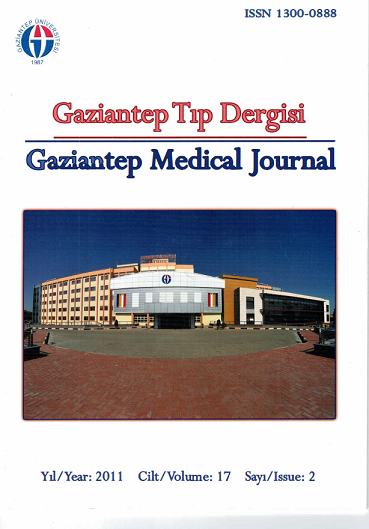Admission appropriateness and profile of the patients attended to a state hospital emergency department
Bir devlet hastanesi acil servisine başvuran hastaların profili ve başvurunun uygunluğu
DOI:
https://doi.org/10.5455/GMJ-30-2011-27Keywords:
Emergency services, patient profile, appropriatenessAbstract
The aim of this study was to determine the profile and appropriateness of the patients’ indications admitted to the emergency department in a state hospital. Adult and pediatric trauma patients admitted to the emergency department of Van State Hospital between March 01 and March 31, 2010, in the course of one month period, were retrospectively analyzed. Data of the 32800 patients admitted to the emergency department during this period were evaluated. Male and female ratio of these patients was 54.8% and 45.2%, respectively, and the most intense group with 77% was the age group of 17-65. The majority of the applications with 60.5% occurred between 8 a.m. and 17 p.m. An examination was asked for 50% of the patients. It was determined that emergency examinations and therapies were applied to 9.9% of the patients, consultation rates were 4.5%, and the highest consultations were taken from orthopedic clinics (16.1%). It was established that 1.4% of the patients were hospitalized, with the highest admission to the general surgery clinic (13.8%). In hospitalized patients, the most common diagnoses were abdominal pain (9.6%), and 88.4% of the patients were discharged from the emergency department. It was observed that the majority of patients admitted to the emergency department need not have been in emergency, and should have applied to primary health care services and policlinics. The results of this study showed that non-emergency patients highly increase the workload of emergency departments, therefore, patients should be trained and awareness of patients should be increased; primary health care services should be made available; accurate, effective and enforceable policies for emergency medical services in the country must be established.
Metrics
References
Derlet RW, Kinser D, Ray L, Hamilton B, McKenzie J. Prospective identification and triage of nonemergency patients out of an emergency department: A 5-year study. Ann Emerg Med 1995;25(2):215-23.
Polat O, Kabaçam G, Güler İ, Ergişi K, Yıldız A. İbn-i Sina Hastanesi Acil Servis’ne başvuran hastaların sürveyans analizi. Türkiye Acil Tıp Dergisi 2005;5(2):78-81.
Ersel M, Karcıoğlu Ö, Yanturalı S, Yürüktümen A, Sever M, Tunç MA. Bir acil servisin kullanım özellikleri ve başvuran hastaların aciliyetinin hekim ve hasta açısından değerlendirilmesi. Türkiye Acil Tıp Dergisi 2006;6(1):25-35.
Kılıçaslan İ, Bozan H, Oktay C, Göksu E. Türkiye’de acil servise başvuran hastaların demografik özellikleri. Türkiye Acil Tıp Dergisi 2005;5(1):5-13.
Andrulis DP, Kellermann A, Hintz EA, Hackman BB, Weslowski VB. Emergency department and crowding in United States teaching hospitals. Ann Emerg Med 1991;20(9):980-6.
Edirne T, Edirne Y, Atmaca B, Keskin S. Yüzüncü Yıl Üniversitesi Tıp Fakültesi Acil Servis hastalarının özellikleri. Van Tıp Dergisi 2008;15(4):107-11.
Oktay C, Cete Y, Eray O, Pekdemir M, Gunerli A. Appropriateness of emergency department visits in a Turkish University Hospital. Croat Med J 2003;44(5):585-91.
Pereira S, Oliveira e Silva A, Quintas M, Almeida J, Marujo C, Pizarro M, et al. Appropriateness of emergency department visits in a Portuguese university hospital. Ann Emerg Med 2001;37(6):580-6.
Gill JM, Mainous AG, Nsereko M. The effect of continuity of care on emergency department use. Arch Fam Med 2000;9(4):333-8.
Aydın T, Aydın ŞA, Köksal O, Özdemir F, Kulaç S, Bulut M. Uludağ Üniversitesi Tıp Fakültesi Hastanesi Acil Servisi’ne başvuran hastaların özelliklerinin ve acil servis çalışmalarının değerlendirilmesi. Akademik Acil Tıp Dergisi 2010:9(4):163- 8.
McCaig LF, Burt CW. National Hospital Ambulatory Medical Care Survey: 2002 emergency department summary, Adv Data 2004;340:1-34.
Shesser R, Kirsch T, Smith J, Hirsch R. An analysis of emergency department use by patients with minor illness. Ann Emerg Med 1991;20(7):743-8.
Woods RA, Lee R, Ospina MB, Biltz S, Lari H, Bullard MJ, et al. Consultation outcomes in the emergency department: exploring rates and complexity. Can J Emerg Med 2008;10(1):25-31.
Vosk A. Response of consultants to the emergency department: a preliminary report. Ann Emerg Med 1998;32(5):574-7.
Nawar EW, Niska RW, Xu J. National Hospital Ambulatory Medical Care Survey: 2005 emergency department summary. Adv Data 2007;386:1-32.
Civaner M. Bir devlet hastanesinin acil servisine başvuran hastaların analizi. Sağlık ve Toplum Dergisi 1999;9(1):3-7.
Afilalo M, Guttman A, Colacone A, Dankoff J, Tselios C, Beaudet M, et al. Emergency department use and misuse. J Emerg Med 1995;13(2):259-64.
Lynn SG, Kellermann AL. Critical decision making: Managing the emergency department in an overcrowded hospital. Ann Emerg Med 1991;20(3):287-92.
Lau FL, Leung KP. Waiting time in an urban accident and emergency department - a way to improve it. J Accid Emerg Med 1997;14(5):299-301.
Gürsoy ŞT, ÇiçeklioğluM, Türk M, Sözbilen M. E.Ü.T.F acil servisine bir yıl içinde başvuran hastaların sosyodemografik özelliklerinin ve başvuru zamanlarının değerlendirilmesi. Ege Tıp Dergisi 1999;38(2):109-12.
Downloads
Published
How to Cite
Issue
Section
License
Copyright (c) 2023 European Journal of Therapeutics

This work is licensed under a Creative Commons Attribution-NonCommercial 4.0 International License.
The content of this journal is licensed under a Creative Commons Attribution-NonCommercial 4.0 International License.


















